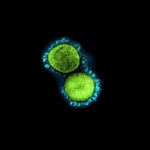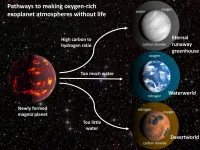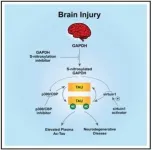(Press-News.org) Almost all bacteria rely on the same emergency valves--protein channels that pop open under pressure, releasing a deluge of cell contents. It is a last-ditch effort, a failsafe that prevents bacteria from exploding and dying when stretched to the limit. If we understood how those protein channels worked, antibiotic drugs could be designed to open them on demand, draining a bacterium of its nutrients by exploiting a floodgate common to many species.
But these channels are tricky to operate in the lab. And how precisely they open and close, passing through a sub-conducting state and ending in a desensitized state under the influence of mechanical forces, remains poorly understood. Now, new research from the laboratory of Rockefeller's Thomas Walz introduces a novel method to activate and visualize these channels, making it possible to explain their function. The findings shed light on key membrane proteins in bacteria, and the same method can be used to improve our understanding of similar channels in humans.
"We were actually able to see the entire cycle of the protein channel passing through a series of functional stages," Walz says.
Walz has long focused upon MscS, a protein embedded in bacterial membranes that opens in response to mechanical force. MscS proteins exist in a closed state while resting in a thick membrane. Scientists once suspected that, when fluid build-up causes the cell to swell and puts tension on the membrane, it stretches so thin that its proteins protrude. Thrust into an unfamiliar environment, the protein channels snap open, releasing the contents of the cell and relieving pressure until the membrane returns to its original thickness and its channels slam shut.
But when Yixiao Zhang, a postdoctoral associate in the Walz group, tested this theory over five years ago, reconstituting MscS proteins into small custom-designed membrane patches, he discovered that it was impossible to prise the channel open by thinning membranes within the natural range. "We realized that membrane thinning is not how these channels open," Walz says.
These custom patches, called nanodiscs, allow researchers to study proteins in an essentially native membrane environment and to visualize them with cryo-electron microscopy. Walz and Zhang resolved to push the limits of nanodisc technology, removing membrane lipids with β-cyclodextrin, a chemical used to excise cholesterol from cell cultures. This induced tension in the membrane, and Walz and his team could observe with cryo-electron microscopy as the channel reacted accordingly--eventually snapping closed for good, a phenomenon known as desensitization.
What they observed matched computer simulations, and a new model for the function of MscS emerged. When fluid builds up inside the cell, they found, lipids are called in from all corners to help ease tension throughout the membrane. If the situation becomes dire, even lipids associated with the MscS channels flee. Without lipids keeping them closed, the channels have the legroom to pop open.
"We could see that, when you expose the membranes to β-cyclodextrin, the channels open and then close again," Walz says.
Walz and Zhang's new method of manipulating nanodiscs with β-cyclodextrin will allow researchers studying dozens of similar mechanosensitive protein channels to, at long last, test their hypotheses in the lab. Many such proteins play key roles in humans, from hearing and sense of touch to the regulation of blood pressure. Of more immediate interest, however, is the prospect of exploiting protein channels that many different bacteria rely upon to survive. Novel drug targets are a particular necessity, given the rise of dangerous antibiotic resistant bacteria such as MRSA.
MscS and the related bacterial protein channel MscL are "extremely interesting drug targets," Walz says. "Almost every bacterium has one of these proteins. Because these channels are so widely distributed, a drug that targets MscS or MscL could become a broad-spectrum antibiotic."
INFORMATION:
A study done in rooms where COVID-19 patients were isolated shows that the virus's RNA - part of the genetic material inside a virus - can persist up to a month in dust.
The study did not evaluate whether dust can transmit the virus to humans. It could, however, offer another option for monitoring COVID-19 outbreaks in specific buildings, including nursing homes, offices or schools.
Karen Dannemiller, senior author of the study, has experience studying dust and its relationship to potential hazards like mold and microbes.
"When the pandemic started, we really wanted to find a way that we could help ...
WHAT:
Many people who have COVID-19 make a full recovery and return to their baseline state of health; however, some people have symptoms or other sequelae weeks or months after initial SARS-CoV-2 infection. These heterogeneous symptoms were the subject of the virtual "Workshop on Post-acute Sequelae of COVID-19" hosted on Dec. 2 and 4, 2020, by the National Institute of Allergy and Infectious Diseases (NIAID), in collaboration with other institutes and centers of the National Institutes of Health. A paper published recently in Annals of Internal Medicine ...
Researchers have identified molecular signatures of the aging process in mice, publishing their results today in the open-access eLife journal.
Their analyses provide one of the most comprehensive characterisations of the molecular signatures of aging across diverse types of cells from different tissues in a mammal, and will aid future studies on aging and related topics.
Aging leads to the decline of major organs and is the main risk factor for many diseases, including cancer, cardiovascular and neurodegenerative diseases. While previous studies have highlighted different hallmarks of the aging process, the underlying molecular and cellular mechanisms ...
In the search for life on other planets, the presence of oxygen in a planet's atmosphere is one potential sign of biological activity that might be detected by future telescopes. A new study, however, describes several scenarios in which a lifeless rocky planet around a sun-like star could evolve to have oxygen in its atmosphere.
The new findings, published April 13 in AGU Advances, highlight the need for next-generation telescopes that are capable of characterizing planetary environments and searching for multiple lines of evidence for life in addition to detecting oxygen.
"This ...
After interviewing various stakeholders from public and private healthcare systems (in Lithuania and the US), researchers Dr Agne Gadeikiene, Prof Asta Pundziene, Dr Aiste Dovaliene from Kaunas University of Technology (KTU), Lithuania designed a detailed structure revealing added value of remote healthcare services, i.e. telehealth. Adopting the concept of value co-creation common in business research to healthcare, the scientists claim that this is the first comprehensive analysis of this kind in the healthcare field involving two different healthcare systems.
According to the researchers, although in the US the consultations via phone with physician have been available for more than fifty ...
A gene therapy protects eye cells in mice with a rare disorder that causes vision loss, especially when used in combination with other gene therapies, shows a study published today in eLife.
The findings suggest that this therapy, whether used alone or in combination with other gene therapies that boost eye health, may offer a new approach to preserving vision in people with retinitis pigmentosa or other conditions that cause vision loss.
Retinitis pigmentosa is a slowly progressive disease, which begins with the loss of night vision due to ...
Violent blows or jolts to the head can cause traumatic brain injury (TBI), and there are currently about five million people in the U.S. living with some form of chronic impairment after suffering a TBI. Even in a mild form, TBI can lead to lifelong nerve cell deterioration associated with a wide array of neuropsychiatric conditions. Tragically, there are no medicines to protect nerve cells after injury. Behind aging and genetics, TBI is the third leading cause of Alzheimer's disease (AD), yet the link between these two conditions is not understood.
In a new study, published online today in Cell, researchers have discovered a new way to prevent brain nerve cells from deteriorating after injury, which also revealed a potential mechanistic ...
AMES, Iowa - Narratives are a powerful tool that can help explain complex issues, but they can also serve as sources of misinformation, which presents a challenge as public health agencies work to educate people about COVID-19 vaccine.
In a paper published by the Proceedings of the National Academy of Sciences, author Michael Dahlstrom, a professor and director of Iowa State University's Greenlee School of Journalism and Mass Communication, examined how narratives or storytelling can help counter misinformation and provide a connection between science and the human experience. Dahlstrom says simply presenting the facts, without some connection, may not help people make ...
Bottom Line: The U.S. Preventive Services Task Force (USPSTF) concludes that the current evidence is insufficient to make a recommendation about screening for vitamin D deficiency in asymptomatic adults. Vitamin D performs an important role in bone metabolism. Requirements may vary by individual and no one blood vitamin D level defines deficiency. The USPSTF routinely makes recommendations about the effectiveness of preventive care services and this recommendation updates and is consistent with its 2014 statement.
To access the embargoed study: Visit our For The Media website at this link https://media.jamanetwork.com/
(doi:10.1001/jama.2021.3069)
Editor's Note: Please see the article for additional ...
New research led by the Garvan Institute of Medical Research has revealed how breast cancer cells that develop during or after pregnancy change their environment to form more aggressive tumours.
In experimental models of pregnancy-associated breast cancer, researchers found that cancer cells send signals to the connective tissue around them to trigger uncontrolled inflammation and remodel the tissue, which in turn helps the cancer to spread.
"Breast cancers that arise during or shortly after pregnancy are highly aggressive as they often become resistant to standard therapies. With 50% of cases ...





